Chapter 1英语国家概况篇章重点
- 格式:ppt
- 大小:7.10 MB
- 文档页数:84
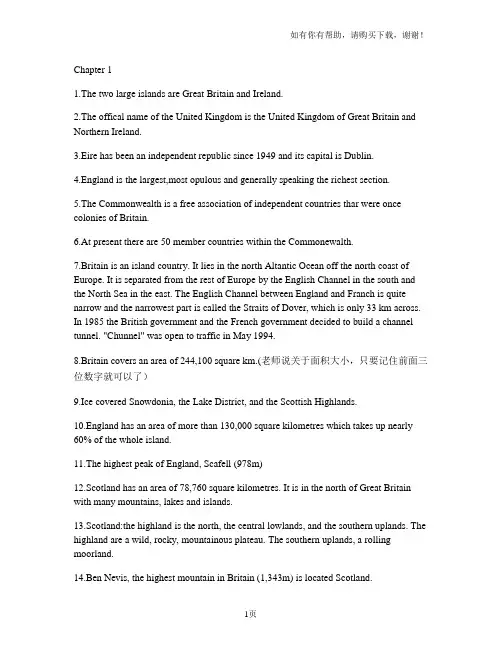
Chapter 11.The two large islands are Great Britain and Ireland.2.The offical name of the United Kingdom is the United Kingdom of Great Britain and Northern Ireland.3.Eire has been an independent republic since 1949 and its capital is Dublin.4.England is the largest,most opulous and generally speaking the richest section.5.The Commonwealth is a free association of independent countries thar were once colonies of Britain.6.At present there are 50 member countries within the Commonewalth.7.Britain is an island country. It lies in the north Altantic Ocean off the north coast of Europe. It is separated from the rest of Europe by the English Channel in the south and the North Sea in the east. The English Channel between England and Franch is quite narrow and the narrowest part is called the Straits of Dover, which is only 33 km across. In 1985 the British government and the French government decided to build a channel tunnel. "Chunnel" was open to traffic in May 1994.8.Britain covers an area of 244,100 square km.(老师说关于面积大小,只要记住前面三位数字就可以了)9.Ice covered Snowdonia, the Lake District, and the Scottish Highlands.10.England has an area of more than 130,000 square kilometres which takes up nearly 60% of the whole island.11.The highest peak of England, Scafell (978m)12.Scotland has an area of 78,760 square kilometres. It is in the north of Great Britain with many mountains, lakes and islands.13.Scotland:the highland is the north, the central lowlands, and the southern uplands. The highland are a wild, rocky, mountainous plateau. The southern uplands, a rolling moorland.14.Ben Nevis, the highest mountain in Britain (1,343m) is located Scotland.15.The western part of highlands and th islands of Hebrides are a very beautiful region.16.Lowland si the most important area in Scotland which contains most fo the industry and population.17.Edinburgh is the capital of Scotland.18.Wales is in the west of Great Britain. It has an area of 20,761 square kilometres which takes up less than 9% fo the whole island. 6% fo Wales is covered with forest and 12% fo the land is arable.19.Snowdonia in the northwest is the highest mountain in Wales.20.The capital of Wales is Cardiff.21.Northern Ireland takes up the northern fifth of Ireland and has an area of 14,147 square kilometres.22.Belfast is the capital of Northern Ireland.23.Rivers in Britain do not freeze in winter. They play a very important role in the country's economy. The great ports of London, Liverpool and Glasgow.24.The longest river is the Severn River (338km);the second larges and most important river in Britain is the Thames River (336km)25.River Clyde is the most important river in Scotland. It's an important commercial waterway.26.There are many lakes in Britain especially in northern Scotland, the Lake District in north-west England and North Wales. The largest lake in Britain is the Lough Neagh in Northern Ireland which covers an area of 396 square kilometres. The Lake District is one of the popular tourist attractions in Britain. Ti is well known for its lake poeter.27.A maritime type of climate.28.It has a favourable maritime climate-winters are mild, not too cold and summers are cool, not too hot, and it has a steady reliable rainfall throughout the whole year.29.Britain's climate influenced mainly by three factors: 1) The surrounding waters tend to balance the seasonal differences by heating up the land in winter and cooling it off in summer. 2) The prevailing south-west winds or the Westerlies blow over the country allthe year round bringing warm and wet air in winter and keeping the temperatures moderate. 3) The North Atlantic Drift, which is a warm current, passes the western coast fo the British Isles and warms them.30.Britain's climate's characterised by cool temperatures, frequent cloudy days and rainstorms.31.Britain has a steady reliable rainfall throughout the whole year. As a result of the rainfall distribution in Britain there is a water surplus in the north and west, and a water deficit in the south and east.32.In 1952 the sulphur dioxide in the four-day London smog, left 4,000 people dead or dying. Britain have introduced "clean air zones" whereby factories and households are only allowed to burn smokeless fuel.33.Britain has a population of 57,411,000,average of 237 people per square kilometre. 90% of the population is urban and only 10% is rural. Especially in Northern Scotland, which are almost uninhabited.34.There is a great concentration of population in England, 47million live in England, 14 million live in London and south-eastern England.35.They take on each other's way of life and this makes it more difficult for people to distinguish between people from different parts of Britain.36.The English are Anglo-Saxons, but the Scots, Welsh and Irish are Celts.37.Welsh is an ancient Celtic language. It wa given equality with English for all official use in Wales in 1965.38.The Welsh are emotional and cheerful people. The great event of the year is the National Eisteddfod, keep the Welsh language and Welsh culture alive.39.Some Germanic Angles settled in the Scottish lowlands and in the borderlands between Scotland and England, but they never invaded the Highlands.40.Though the Scots are said to be a serious, cautious and thrifty people, today most visitors to Scotland come away with an impression that they are hospitable, generous and friendly.41.English Protestants there has been bitter fighting Catholics, who are seeking more。
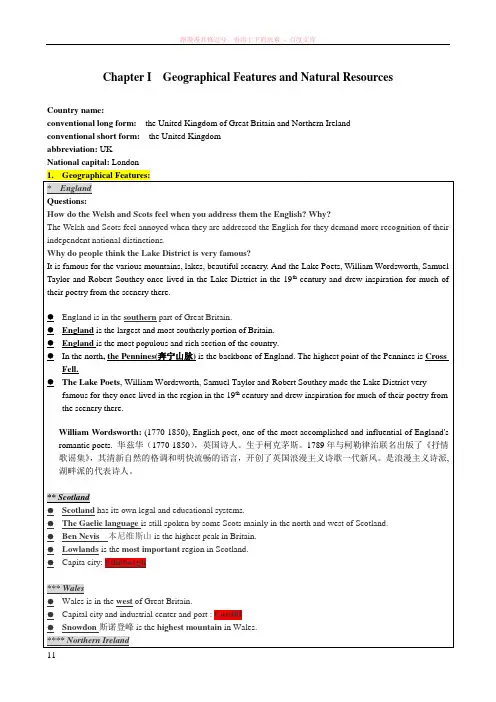
Chapter I Geographical Features and Natural ResourcesCountry name:conventional long form:the United Kingdom of Great Britain and Northern Irelandconventional short form:the United Kingdomabbreviation: UKNational capital: London1.Geographical Features:* EnglandQuestions:How do the Welsh and Scots feel when you address them the English? Why?The Welsh and Scots feel annoyed when they are addressed the English for they demand more recognition of their independent national distinctions.Why do people think the Lake District is very famous?It is famous for the various mountains, lakes, beautiful scenery. And the Lake Poets, William Wordsworth, Samuel Taylor and Robert Southey once lived in the Lake District in the 19th century and drew inspiration for much of their poetry from the scenery there.●England is in the southern part of Great Britain.●England is the largest and most southerly portion of Britain.●England is the most populous and rich section of the country.●In the north, the Pennines(奔宁山脉) is the backbone of England. The highest point of the Pennines is CrossFell.●The Lake Poets, William Wordsworth, Samuel Taylor and Robert Southey made the Lake District veryfamous for they once lived in the region in the 19th century and drew inspiration for much of their poetry from the scenery there.William Wordsworth: (1770-1850), English poet, one of the most accomplished and influential of England's romantic poets. 华兹华(1770-1850),英国诗人。
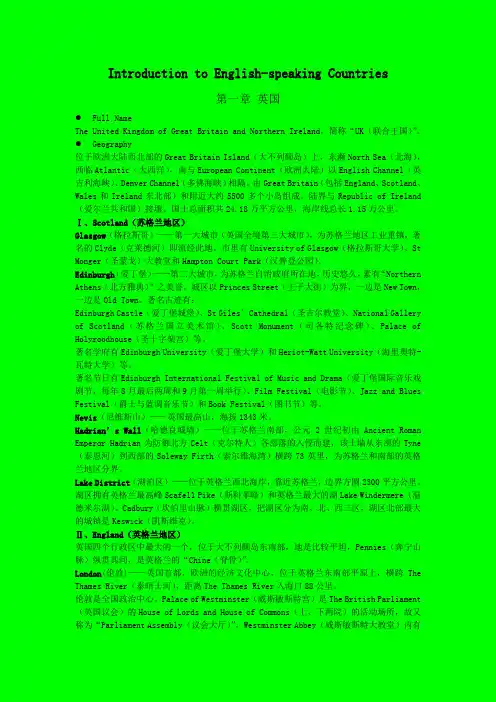
Introduction to English-speaking Countries第一章英国●Full NameThe United Kingdom of Great Britain and Northern Ireland,简称“UK(联合王国)”。
●Geography位于欧洲大陆西北部的Great Britain Island(大不列颠岛)上,东濒North Sea(北海),西临Atlantic(大西洋),南与European Continent(欧洲大陆)以English Channel(英吉利海峡)、Denver Channel(多佛海峡)相隔。
由Great Britain(包括England、Scotland、Wales和Ireland东北部)和附近大约5500多个小岛组成。
陆界与Republic of Ireland (爱尔兰共和国)接壤。
国土总面积共24.18万平方公里,海岸线总长1.15万公里。
Ⅰ、Scotland(苏格兰地区)Glasgow(格拉斯哥)——第一大城市(英国全境第三大城市),为苏格兰地区工业重镇,著名的Clyde(克莱德河)即流经此地。
市里有University of Glasgow(格拉斯哥大学)、St Monger(圣蒙戈)大教堂和Hampton Court Park(汉普登公园)。
Edinburgh(爱丁堡)——第二大城市,为苏格兰自治政府所在地,历史悠久,素有“Northern Athens(北方雅典)”之美誉。
城区以Princes Street(王子大街)为界,一边是New Town,一边是Old Town。
著名古迹有:Edinburgh Castle(爱丁堡城堡)、St Giles′Cathedral(圣吉尔教堂)、National Gallery of Scotland(苏格兰国立美术馆)、Scott Monument(司各特纪念碑)、Palace of Holyroodhouse(圣十字架宫)等。
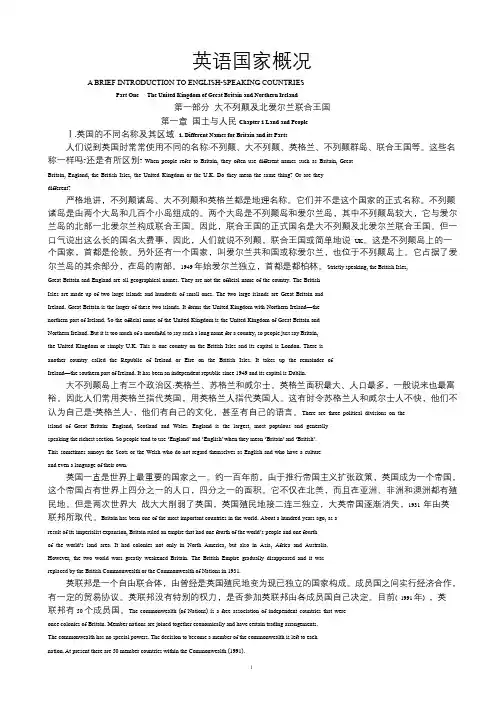
英语国家概况A BRIEF INTRODUCTION TO ENGLISH-SPEAKING COUNTRIESPart One The United Kingdom of Great Britain and Northern Ireland第一部分大不列颠及北爱尔兰联合王国第一章国土与人民Chapter 1 Land and PeopleⅠ.英国的不同名称及其区域 1. Different Names for Britain and its Parts人们说到英国时常常使用不同的名称:不列颠、大不列颠、英格兰、不列颠群岛、联合王国等。
这些名称一样吗?还是有所区别? When people refer to Britain, they often use different names such as Britain, GreatBritain, England, the British Isles, the United Kingdom or the U.K. Do they mean the same thing? Or are theydifferent?严格地讲,不列颠诸岛、大不列颠和英格兰都是地理名称。
它们并不是这个国家的正式名称。
不列颠诸岛是由两个大岛和几百个小岛组成的。
两个大岛是不列颠岛和爱尔兰岛,其中不列颠岛较大,它与爱尔兰岛的北部一北爱尔兰构成联合王国。
因此,联合王国的正式国名是大不列颠及北爱尔兰联合王国。
但一口气说出这么长的国名太费事,因此,人们就说不列颠,联合王国或简单地说UK。
这是不列颠岛上的一个国家,首都是伦敦。
另外还有一个国家,叫爱尔兰共和国或称爱尔兰,也位于不列颠岛上。
它占据了爱尔兰岛的其余部分,在岛的南部。
1949 年始爱尔兰独立,首都是都柏林。
Strictly speaking, the British Isles,Great Britain and England are all geographical names. They are not the official name of the country. The BritishIsles are made up of two large islands and hundreds of small ones. The two large islands are Great Britain andIreland. Great Britain is the larger of these two islands. It forms the United Kingdom with Northern Ireland—thenorthern part of Ireland. So the official name of the United Kingdom is the United Kingdom of Great Britain andNorthern Ireland. But it is too much of a mouthful to say such a long name for a country, so people just say Britain,the United Kingdom or simply U.K. This is one country on the British Isles and its capital is London. There isanother country called the Republic of Ireland or Eire on the British Isles. It takes up the remainder ofIreland—the southern part of Ireland. It has been an independent republic since 1949 and its capital is Dublin.大不列颠岛上有三个政治区:英格兰、苏格兰和威尔士。
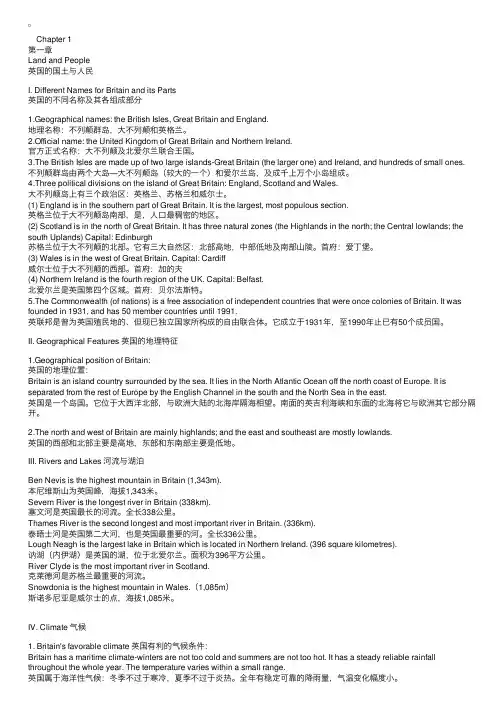
Chapter 1第⼀章Land and People英国的国⼟与⼈民I. Different Names for Britain and its Parts英国的不同名称及其各组成部分1.Geographical names: the British Isles, Great Britain and England.地理名称:不列颠群岛,⼤不列颠和英格兰。
2.Official name: the United Kingdom of Great Britain and Northern Ireland.官⽅正式名称:⼤不列颠及北爱尔兰联合王国。
3.The British Isles are made up of two large islands-Great Britain (the larger one) and Ireland, and hundreds of small ones.不列颠群岛由两个⼤岛—⼤不列颠岛(较⼤的⼀个)和爱尔兰岛,及成千上万个⼩岛组成。
4.Three political divisions on the island of Great Britain: England, Scotland and Wales.⼤不列颠岛上有三个政治区:英格兰、苏格兰和威尔⼠。
(1) England is in the southern part of Great Britain. It is the largest, most populous section.英格兰位于⼤不列颠岛南部,是,⼈⼝最稠密的地区。
(2) Scotland is in the north of Great Britain. It has three natural zones (the Highlands in the north; the Central lowlands; the south Uplands) Capital: Edinburgh苏格兰位于⼤不列颠的北部。
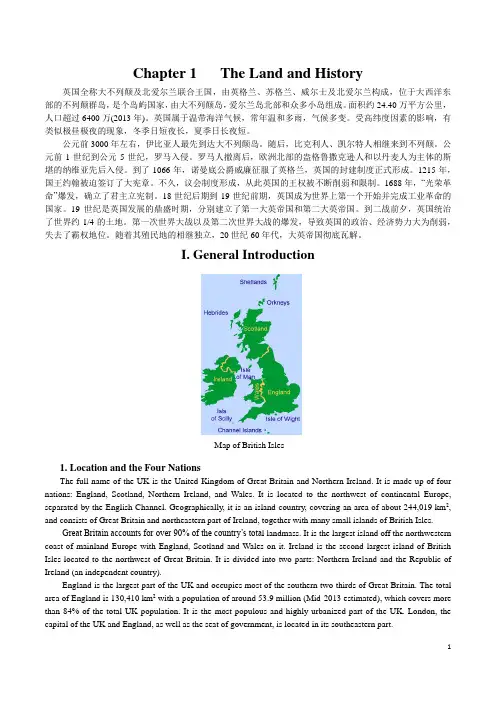
Chapter 1 The Land and History英国全称大不列颠及北爱尔兰联合王国,由英格兰、苏格兰、威尔士及北爱尔兰构成,位于大西洋东部的不列颠群岛,是个岛屿国家,由大不列颠岛,爱尔兰岛北部和众多小岛组成。
面积约24.40万平方公里,人口超过6400万(2013年)。
英国属于温带海洋气候,常年温和多雨,气候多变。
受高纬度因素的影响,有类似极昼极夜的现象,冬季日短夜长,夏季日长夜短。
公元前3000年左右,伊比亚人最先到达大不列颠岛。
随后,比克利人、凯尔特人相继来到不列颠。
公元前1世纪到公元5世纪,罗马入侵。
罗马人撤离后,欧洲北部的盎格鲁撒克逊人和以丹麦人为主体的斯堪的纳维亚先后入侵。
到了1066年,诺曼底公爵威廉征服了英格兰,英国的封建制度正式形成。
1215年,国王约翰被迫签订了大宪章。
不久,议会制度形成,从此英国的王权被不断削弱和限制。
1688年,“光荣革命”爆发,确立了君主立宪制。
18世纪后期到19世纪前期,英国成为世界上第一个开始并完成工业革命的国家。
19世纪是英国发展的鼎盛时期,分别建立了第一大英帝国和第二大英帝国。
到二战前夕,英国统治了世界约1/4的土地。
第一次世界大战以及第二次世界大战的爆发,导致英国的政治、经济势力大为削弱,失去了霸权地位。
随着其殖民地的相继独立,20世纪60年代,大英帝国彻底瓦解。
I. General IntroductionMap of British Isles1. Location and the Four NationsThe full name of the UK is the United Kingdom of Great Britain and Northern Ireland. It is made up of four nations: England, Scotland, Northern Ireland, and Wales. It is located to the northwest of continental Europe, separated by the English Channel. Geographically, it is an island country, covering an area of about 244,019 km2, and consists of Great Britain and northeastern part of Ireland, together with many small islands of British Isles.Great Britain accounts for over 90% of the country’s tota l landmass. It is the largest island off the northwestern coast of mainland Europe with England, Scotland and Wales on it. Ireland is the second largest island of British Isles located to the northwest of Great Britain. It is divided into two parts: Northern Ireland and the Republic of Ireland (an independent country).England is the largest part of the UK and occupies most of the southern two thirds of Great Britain. The total area of England is 130,410 km2 with a population of around 53.9 million (Mid-2013 estimated), which covers more than 84% of the total UK population. It is the most populous and highly urbanized part of the UK. London, the capital of the UK and England, as well as the seat of government, is located in its southeastern part.Scotland is the second largest and most mountainous part of the UK in the north of Great Britain. Compared with that of England, the population density is quite low. There are only 5.3 million people with an area of 78,789 km2. Edinburgh, its largest city, is the capital of Scotland. Scotland is famous for its beautiful natural scenery, such as Scottish Highlands1and Loch Ness2, as well as many historical places, like the Edinburgh Castles.Wales is on the western side of central southern Great Britain. The total area of Wales is 20,779 km2, which accounts for 1/4 parts of the UK. It is also a mountainous part of Great Britain, particularly in the north and central regions. The southeast region is the most built up region of Wales, and the majority of its population live there and a large proportion of its industry is based there. Its capital city, Cardiff, is also in this region.Northern Ireland lies in the northeast of the island of Ireland, covering14,139 km2, which constitutes 1/6 of the island. It is the smallest part among the four nations of the UK, as well as the second sparsely populated part after Scotland. The capital is Belfast, the largest city in Northern Ireland both in population and in area. It is the center for government, economic, arts, higher education, business, law of Northern Ireland. Additionally, it is the birthplace of Titanic, and voted one of the world’s top destinations.2. ClimateThe overall climate in the UK is temperate maritime, which means that it is mild with temperatures neither much lower than 0℃in winter nor much higher 32℃in summer. Generally, the UK has warm summers and cool winters, with July and August as the warmest month, and January and February as the coldest. However, due to the influence of Gulf Stream3, the summers are cooler than those in continent while the winters are milder. Normally, the temperature in summer is around 20℃,with the high rarely going above 30℃. The average temperature in winter is around 0℃and seldom go below -10℃even in the most northern part of the country.Meanwhile, since Britain is an island country and surrounded by the sea, the climate is considerably changeable compared with other countries. Since the variable climate changing day to day, it is hard for people to predict what the weather will be like the next day. Additionally, the unique geographical position is also the reason for the dampness of the climate. The rainfall is fairly distributed throughout the year. Although it does not rain every day, it is always advisable for people to bring an umbrella or waterproof clothing every day.II. History1. The Founding of the NationThe recorded history of the UK begins with the Roman invasion in 55BC. In 55 and 54BC, Britain was twice invaded by Julius Caesar and his Roman troops. However, it was not until 43AD that the Roman led by Claudius I finally successfully invaded and Britain became part of the Roman Empire. The native Celtic were driven to the mountain regions of Scotland and Wales, which remained unconquered by the Romans.The Romans have great impact on many aspects of the British culture. The Roman civilization was introduced to the Britain during this period. For example, Roman style baths and temples were built, cities like London and towns were constructed, and the system of government was also introduced. With the decline of the Roman Empire, when the Germanic troops attacked Rome in 410 A.D., the Romans had to withdraw in order to protect their own nation, which led to the end of Roman occupation.After the leave of the Romans, three groups of Germanic tribes called the Jutes, the Angles and the Saxons came to Britain from the European continent in the mid-4th century. They conquered different regions of Britain:1Scottish Highlands:苏格兰高地,是对苏格兰高地边界断层以西和以北的山地的称,被认为是欧洲风景最优美的地区。

![英美概况笔记(中英文对照整理版)[1]](https://uimg.taocdn.com/497d6ac0102de2bd96058871.webp)
英美国家概论路人整理2011-7-27目录第一章英国的国土与人民LAND AND PEOPLE (3)第二章英国的起源THE ORIGINS OF A NATION (9)第三章英国的形成THE SHAPING OF THE NATION (16)第四章向现代英国的过渡TRANSITION TO THE MODERN AGE (22)第五章大英帝国的兴衰THE RISE AND FALL OF THE BRITISH EMPIRE (28)第六章英国经济THE ECONOMY (40)第八章法律与司法机构JUSTICE AND THE LAW (49)第九章英国社会SOCIAL AFFAIRS (55)第十章体育运动SPORTS (60)第十三章美国地理位置GEOGRAPHY (66)第十四章美国人口种族POPULATION.RACE AND ETHNIC GROUPS (70)第十五章美国历史(一)AMERICAN HISTORY(I) (73)第十六章美国历史(二)AMERICAN HISTORY(II) (77)第十七章美国历史(三)AMERICAN HISTORY(III) (81)第十八章美国经济THE ECONOMY (84)第十九章政治制度POLITICAL INSTITUTION (88)第二十章美国教育EDUCATION (93)第二十一章文化建筑和音乐LITERATURE, ARCHITECTURE AND MUSIC (98)第二十二章节日和假期HOLIDAYS AND FESTIVALS (102)第二十二章节:HOLIDAYS AND FESTIVALS 节日和假期 (102)第一章英国的国土与人民Land and PeopleI. Different Names for Britain and its Parts英国的不同名称及其各组成部分1.Geographical names: the British Isles, Great Britain and England.地理名称:不列颠群岛,大不列颠和英格兰。
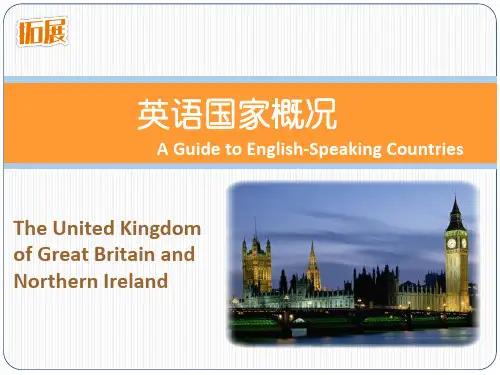
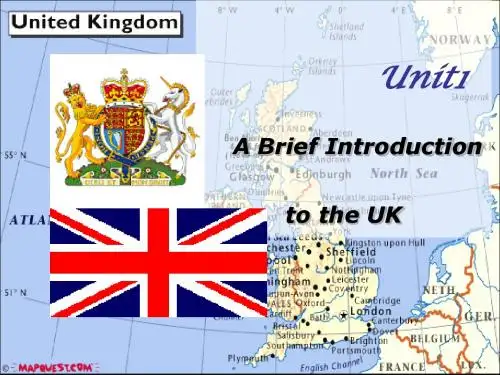
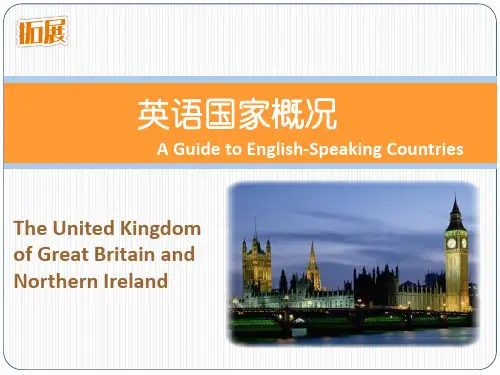
The United Kingdom of Great Britain and Northern Ireland英国的历史分四部分:1.The Origins of a Nation2.The Shaping of the Nation3.Transition to the Mordern Age4.The Rise and Fall of the British EmpireHistory of UKEarly settlers -> Roman Britain -> Anglo-Saxons -> the Viking and Danish Invations -> the Norman ConquestNorman Rule -> the Great Charter -> the Hundred Years' War with France -> the Blackdeath and the peasant uprisingthe English Reformation -> Elizabeth I -> the English Renaissance -> James I -> Charles I -> the Civil War -> the commonwealth -> the Glorius RevolutionTwo parties (Whigs and Tories) -> Agricultural changes -> the Industrial Revolution -> the Chartist Movement -> Trade unions and the Labour Party -> Colonial Expansion -> in the two World WarsChapter 1 Land and People第一部分:Different Names for Britain and its Parts1. 选择题/ 简答题:The official name of the United Kingdom is the United Kingdom of Great Britain and Northern Ireland2.选择题/ 简答题:The British Isles are made up of two large islands-Great Britain (the larger one) and Ireland, and hundreds of small ones.There are three political divisions on the island of Great Britain:England, Scotland and Wales3.简答题:Why do people tend to use "England" and "English" when they mean "Britain" and "British"?England is the largest, most populous and generally speaking the richest section. So people tend to use “England” and “English” when they mean “Britain” and “British”.4.名词解释:the Commonwealth of Nations 或the British CommonwealthThe Commonwealth is a free association of independent countries that were once colonies of Britain. Member nations are joined together economically and have certain trading arrangements. The Commonwealth has no special powers.。
Unit1 A Brief Introduction to the United Kingdom 1.The flag of Britain : Union Jack(英国国旗中没有显示出Welsh旗)2. The basic information of each country:Count ry Capital AreaMemoEngland London最大1.最不会把自己的“英格兰文化区别于其他文化”2.一个高度城市化3.The time joining the British parliament: However, in 1707 by agreement of the English and Scottish parliaments, Scotland joined the Union.4.Difference between the British Isles ,UK, Great Britain , and England:British Isles:the island of Great Britainthe island of Irelandsurrounding isles●UK=Great Britain + Northern Ireland●Great Britain =England +Scotland + Wales5.The four major invasions in the history of Great Britain :At first, England was occupied by Celtic people.Then in 43AD Britain was invaded by the Roman Empire.Result: England and Wales became a part of the Roman Empire for nearly 400 years.the Angle-Saxon invaded.Result: The land they lived became" Angle-land", later changed into England, the language they spoken became English.PS:One of the best-known English legends derives from this time. In 5 century AD, King Author(亚瑟王) united the British, and with his magical sword, Excalibur(被称为“王者之剑”的圣剑),drove the Saxons back.关于亚瑟王的一些名词:Excalibur:被称为“王者之剑”的圣剑;亚瑟王之魔剑Castle at Tintagel(廷塔杰尔) in Cornwall: Tintagel传说为亚瑟王的诞生地,这是一个与亚瑟王传奇有关的地方。
英国国家概况(一)(中英文版)第一章英国的国土与人民第一章Land and People英国的国土与人民I. Different Names for Britain and its Parts英国的不同名称及其各组成部分1.Geographical names: the British Isles, Great Britain and England.地理名称:不列颠群岛,大不列颠和英格兰。
2.Official name: the United Kingdom of Great Britain and Northern Ireland.官方正式名称:大不列颠及北爱尔兰联合王国。
3.The British Isles are made up of two large islands-Great Britain (the larger one) and Ireland, and hundreds of small ones.不列颠群岛由两个大岛-大不列颠岛(较大的一个)和爱尔兰岛,及成千上万个小岛组成。
4.Three political divisions on the island of Great Britain: England, Scotland and Wales.大不列颠岛上有三个政治区:英格兰、苏格兰和威尔士。
(1) England is in the southern part of Great Britain. It is the largest, most populous section.英格兰位于大不列颠岛南部,是最大,人口最稠密的地区。
(2) Scotland is in the north of Great Britain. It has three natural zones (the Highlands in the north; the Central lowlands; the south Uplands) Capital: Edinburgh苏格兰位于大不列颠的北部。
英语国家概况的复习重点英语国家概况六国比较国英语国家概况 - 地理、人口、气候篇 [UseMoney=8]一、地理位置,面积: 英国:The United Kingdom of Great Britain and Northern Ireland Britain is an island country. It is surounded by the sea. It lies in the north Atlantic Ocean off the north coast of Europe.It is separated from the rest of Europe by the English Channel in the south and the Borth sea in the east. The Britain covers an area of 244,100 square kms. It runs 1,000 kms from north to south and extends, at the widest part, about 500 kilometres. 美国:the United States of America The continental United States lies in central North America with Canada to its north.Mexico and the Gulf of Mexico to its South,the Atlantic Ocean to its east and the Pacific Ocean to its west.The two newest states Alaska and Hawaii are separated from the continetal United States.(Joined in 1959) The U.S. has a land area of 9.3 million square kilometres(the 4th largest country in the world).It streches 2,575 kilometres from north to south and 4,500 kilometres from east to west. 爱尔兰:the Republic of Ireland(Eire) The Republic of Ireland covers an area of 70,282 sq.km.The cuntry's total boundary si 3,603 km long,of which its land border with Northern Ireland is 434 km. It is bounded on the northeast by Northern Ireland,on the east and southeast by the Irish Sea and St. Geogore's Channel and on the north and west by the Atlantic Ocean. 加拿大:Canada Canada is the world's second largest country after Russia. It has a land area of about 10 million sq.km. It covers about two fifths of North American comtinent.North to South(3,200 kilometres),east to west(6,400 kilometres).Canada and United States share a 6,378 kilometre boundary that has not been fortified for over a hundred years. Canada lies to the north of the United States.The 45th parallel marks the boundary between Canada and norhtern Vermont and New York of the United States. 澳大利亚:Australia Australia streches from 10 south to 44 south of latitude and 113 east to 154 east of longitude. Australia is the world's smallest continent with an area of 7.7 milion sq.km. But Australia is the sixth largest country in the world. It surrounded by the Tasman Sea and the Pacific Ocean to the east,by the Indian Ocean to the west,by the Coral Sea,the Atlantic Sea and Timor Sea to the north,and the Southern Indian Ocean and the Great Australian Bight to the south. 新西兰:New Zealand New Zealand is in the Southern Pacific Ocean,halfway between the equator and South Pole. About 1,500 km to the northwest,across the Tasman Sea,is Australia. To the east,10,600 km of the Pacific Ocean separate New Zealand from South America.The icy continent of Antarctica lies 2,300 km to the south. The latitude of the capital city,Wellington,is 40S;the latitude of China's capital is 40N.It is just west of the International Date line,so it is the first country to get the new day. The size of the country is similar to Britain or Japan.三、气候,人口英国: Britain has a population of 57,411,000(1990). A maritime type of climate. Winters are mild,not too cold and summers are cool,not too hot,and it has a steady reliable rainfullthroughtout the whole year. It has a small range of temperature. 美国: The United States of America,with a population of 255.5 million in July 1992,is the third most populous country in the wrold. By the year 2050,the population is expected to climb to 383 million,a50% increase. The United States is located in the middle latitudes north of the equator. And there are different types of climate in different regions. 1)A humid continental climate is found in the north-eastern part of the country.(New England) 2)In the south-eastern United States you can find a humid subtropical climate. *these two zones stretch westward across the United States until they approach the 100th meridian. 3)Beyond this point they gradually give way to the continental steppe climate of the Great Plains. 4)The Pacific northwest is favoured with a maritime climate. 5)The souther part of the Pacific coast in California has a Mediterranean climate. 爱尔兰: The population of Ireland in 1990 was estimated at 3.5 million. It is expected to grow to 4 million by 2000. The weather of Ireland is described as "mild,moist and changeable".Extreme cold,long frosts,heavy snows in winter and scorching days in summer are uncommon. 加拿大: Canada has a population of only a little over 29 million(1994).Toronto(3.4 million),Montreal(2.9 million)and Vancouver(1.3 million) are the most populous cities in Canada. Except for southwestern Saskatchewan and southeastern Alberta,Canada recieves adequate rainfall.However the climate throughout Canada is varied. 1)A maritime climate similar to that of Washington and Oregon states in the United States is found in the southwestern part of British Colombia. 2)North of these regions lie the evergreen forests of the subarctic taiga. 3)In the far north there is a polar climate with a treeless tundra zone Generally speaking the climate in Canada is unfavourable.Much of Cananda has long and cold winters with deep snow. 澳大利亚: Today(1996) Australia's population is about 18 million or about two people to the square kilometre. Most Australia do not know their continent very well because they live on the cool,wet,forested south-east coastland. This is the most pleasant part of the country and the forests are unique but it is not Australia's most common environment. Two thirds of the coutry is hot and dry. 新西兰: The population of New Zealand is 3.5 million. Approximately 10% are Maori,or part Maori. The climate in New Zealand is generally temperate,but becasue the country runs northsouth,the climate is varied. In the far north it is subtropical and in some mountainous areas of South island it is almost subarcitc.Seasonal variations are less extreme than in many other countries. 英语国家概况 - 政治篇一、基本政治制度和国家元首[UseMoney=8]英国: The United Kingdome is a constitutional monarchy:the head of States is a king or a queen. In practice,the Sovereign reigns,but does not rule:the United Kongdom is governed,in the name of the Sovereign,by His or Her Majestty's Government--a body of Ministers who are the leading members of whichever political party the electorate has voted into office,and who are responsible to Parliament. The present Sovereign is Queen Elizabeth II. 美国: The American Consitution set up a federal systerm of government which has two layers of rule.(central of federal government for the nation ,state and local governments.) The President of the Unites States is head of the executive branch. The White House is hisofficial residence. He is also head of state elected by the whole nation.(4years,two times at the most) 爱尔兰: Ireland is a parliamentary republic and a unitary state under the 1937 Consitution. The head of the state is the president.(7years) 加拿大: Canada,a self-governing memeber of the Commonwealth of Nations,is a federation of 10 povinces and two territories. Canada, along with Australia, New Zealand and some other Commonwealth countries, recognizes Britain' monarch, Queen Elizabath II, as Head of State. 澳大利亚:The Commonwealth of Australia is a federation.The Six colonies joined together as sovereign States. 新西兰: New Zealand is a sovereign independent State,which a parliament government and a constitutional monarchy立法机构 ,执法机构[UseMoney=8]二、立法机构英国:Parliament(maximum 5 years duration)Parliament consisted of the Sovereign,the House of Lords(made up of the Lords Spiritual and the Lords Temporal) and House of Commons(651).美国:CongressArticle I of the Constitution grants all legislative power of the federal government to a Congress composed of two chambers,a Senate(two members from each state,six year term and every even year,one-third of the Senate stands for re-election ) and a House of Representatives(based on population and its size is therefore not specified in the Constitution.435).爱尔兰:All the legislative power are vested in the national parliament.(Oireachats) Oireachats has two houses. They are the Senate(Seanad) and the House of Representives(Dail Eireann)加拿大:All the legislative power of the federal administration are vested in the Parliament of Canada,which consists of the Crown,the Senate(104) and the House of Commons(295).Therefore,laws must be passed by both Houses of Parliament and signed by the Governor-General in the Queen's name.澳大利亚:The Australian Federal Parliament is modelled on the Westminster system.It is the Legislature.It consists of the Queen and two Houses of Parliament:the House of Representatives and the Senate. 新西兰:New Zealand follows the British Parliamentary system with some varitions.Since 1950 the New Zealand Parliament has had only one chamber,the House of Representatives. (every 3 years)三、执法机构英国:The Prime Minister is apointed by the Queen.He always sits in the House of Commons.And his residence is No.10 Downing Street in London.The party which wins sufficient seats at a General Election to command a majority of supporters in the House of Commons usually forms the Government.Ministers are appointedby the Queen on the recommendation of the Prime Minister. The most senior ministers compose the Cabinet.美国:The head of the departments,chosen by the President and approved by the Senate,form a council of advisers generally known as the President. This inculdes the White House staff,the Office of Management and Budget,the Council of Economic Advisers,and the Office of Emergerency Preparedness. The department are as follows(不打上来了,是书上的P305)爱尔兰:The Article 13 of the Constitution provides that the president shall appoint the prime minister(toiseach) on the nomination of the House of Representatives(Dail) and that he shall appoint the other members of the government on the nomination of the prime minister with the previous approval of the Dail.The prime minister holds office either until he chooses to resign or until he loses the support of the majority in the Dail.加拿大:Queen is represented in Canada by the Governor-General,who is appointed on the recommendation of the Prime Minister. In practice, the Governor-General acts only the advice of the Canada Prime Minister and the Cabinet, who also sit in the federal parliament.The Prime Minister and other members of the Cabinet exercise executive power as the "Government".澳大利亚:In Australia the Queen is represented by the Govenor-General.(这里和加拿大是完全一样的) The executive is the government of the day.It is formed by the party or coalition of parties,which has a majority of seats in the House of Representatives.The Executive consists of the Prime Minister and the other members of the ministry.新西兰:The leader of the party with a majority of members in the House of Representatives becomes Prime Minister.He or she and about 20 other chosen members,form the Cabinet.党派,司法机构[UseMoney=8]四、党派英国:Since the 1945 eiher the Conservative Party or the Labour Party has held power.A new party--the Social and Liberal Democratic Party was formed in 1988.美国:In general,America has a two-party system.The Democrats(the major party now) and the Republicans.爱尔兰:Ireland has a bipolar political system with two major paries,Finna Fail and Fine Gael.The Irish Labour Party is the oldest of all the parties in Ireland. The Progressive Democrats is the largest of the minor partiesafter 1987 election.加拿大:Two party system and one party rule.There are two main federal parties in Canada.They are the Liberal Party and the Progressive Conservative Party.澳大利亚:We can say that Australia has a two-and-half party system of the ALP(Australia Labour Party) on one side and the Liberal Party and National parties on the other.新西兰:For the last 50 years the two main parties have been the National party and the Labour Party.五、司法机构英国: Criminal Courts in England and Wales including: Magistrates Courts,Youth Courts and the Crown CourtsScotland: 1.the High Courts of Justiciary 2.the sheriff court 3. the district court Northern Ireland: Magistrates' courts,Country courts and the Crown CourtCivil Courts in England and Wales: are the Country Court of which there are 270.The High Court deal with the more complicated cases.Scotland:the civil courts are the sheriff court and the Court of Session.Northern Ireland:Country courts are primarily civil law courts. The magistrates' court also deals with certain limited classes of civil cases.The High Court of Justice is the superior civil law court.Appeals from country courts are dealt with by the High Court or the Court of Appeal.美国:The judicial,consists of a system of courts headed by the Supreme Court and including subordinate courts throughtout the country.And it is the organ which has the power to interpret the Constitution.The judicial system has evovlved into the present structure:the Supreme Court,11 courts of appeals,91 district courts,and three courts of special jurisdiction.爱尔兰:Statutes passed by the British Parliament before 1921 have the force of law except those repealed by the Irish Oireachats.The high court has full origianal jurisdiction and power in all matters of law.It also can determine the validity of any law within the provisions of the Constitution.The Supreme Court is the court of final appeal.(a chief jusice and six other jusices)加拿大:Canada law has its source in acts and judicial decisions,and also in British common law. Quebec is an exception since its system is based on the French civil law.The provincial and federal governments have the power to establish courts. The federal Parliament created the Supreme Court of Canada,the Federal Court and various of special jurisdiction.澳大利亚:The High Court is the most superior.It consists of a chief jusice and six other jusices.The Federal Court of Australia was established in 1977.The Family Court was established in 1976.In each state there is a Superior Court. Below it are intermediate courts commonly called District or County Courts. Below them are Magistrates Courts,Local Courts or Courts of Petty Session. 二、农业[UseMoney=8]英国: The Britain were pioneers in modern agriculture and were among the first to bring science and machinery to farming.The new farming has been called "agribusiness".There are mainly six farming types in Britain.They are arable farning,dairy fariming,stock farming,mixed farming,hill farming and market gardening. Because of the cool climate,apples,pears and plums grwo very well in Britain. The North Sea has very good fishing grounds. 美国: Yet the United States grows nearly one fourth of the world's grain and supplies a half of all the exports of grain in the world. It ranks first,second,or third in the production and export of corn, wheat, rice, soybeans, oranges, meat,milk, apples,oats,cotton,tobaoo, peanuts,and edible vegetable oil.(具体的在什么地方种什么东西可以参照书上P289-291) 爱尔兰: Agriculture generates anestimated 11% of the Ireland GNP,employs 17% of the labour force and produces 25% of total exports. The most signigicant recent development in Irish agriculture has been membership in the European Community. 加拿大: The land used for agriculture makes up only 7% in Canada. Canada farms specialize in producing wheat,food crops for animals dairy products,and fruit.Fishing and mining are quite important. The Canada Prairie is the centre of a rich wheat belt. Eastern Canada is noted for a variety of farm products. Dairying is in the lowlands of Quebec and Ontario. Fruits are grown in Western Nova Scotia. 澳大利亚: Today,agriculture is the nation's largest and most diverse industry.Australia is one of the world's leading producers of foodand natural fibres.Australia is the world's largest exporter of wool,the second largest exporter of meat,the third largest exporter of wheat and a major international supplier of sugar,dairy products,fruits,cotton and rice. Australia's agriculture importance has declined in recent years. 新西兰: Vineyards produce international award-winning red and white wines. 四、对外贸易[UseMoney=8]英国: Britain is the fifth largest trading country in the world.Napoleon called it a "nation of shopkeepers" Britain's foreign trade is mainly with other developed countries. Which accounts for 79% of exports and 85% of imports. About half with EC. Traditionally,Britain has had a deficit on visible trade and a surplus on invisible trade. 美国: Currenty U.S. exports are about 15% of the world's total.The Unites States imports about 13% of all world imports. Canada is the largest single source og goods imported by the U.S.,accounting for nearly 30% of the total. Outside of North America,Europe is the largest source of imports with about 30%,Asia provides about 18%,with smaller percentages from Latin America,Africa,and Australia. 爱尔兰: Successive Irish governments have adopted a consistent and postive approoach toward attracting overseas investment. The new foreign firms now account for over 70% of manufactured exports. Ireland is new an industrial exporter. Manufactured goods account for about two-thirds of total wxports. 加拿大: A total about four fifths of all foreign investments in Canada are American. 澳大利亚: Australia is a middle-level trading nation. The main feature of Australia's trade is that it has always involved the exchange of raw materials for finished products. Australia's trade relations with China have been developing rapidly in recent years. China accouts for about 3% of Australian total exports. 新西兰: Trade is New Zealand's linelihood.Foreign investment is increasing and financial markets are active. Western Europe and particularly Britain have traditionally been New Zealand's major export market. The main imports are industrial raw materials,capital equipment and consumer goods. New Zealand is the world's largest exporter of lamb and mutton as well as dairy products. 五、当今面临的问题[UseMoney=8]英国: Britain is the oldest industrial country in the world.The term "Britain disease" is noew often used to characterise Britain's economic decline. The Evolution of the Britain Economy since the War:1.Steady development in the 50s and 60s.2.Economic recession in the 70s.3.Economic recovery in the 80s. 这里有一部分是撒切尔的宏,微观措施比较重要(P91-92) 美国: The Untied States has a free-market economy with a dominant private sector So the economy system of the United States is principally privately owned.But today,many of American people still live under the poverty line. Unemployment,inflation,finacial deficit,and trade deficit are the troubles that alwaysface the United States. 爱尔兰: The value of imports generally exceeds that of exports. That's why Ireland has a chronic negative balance of trade. Continuing dependence on imported oil is one of the reasons for the high import bill. 加拿大: In the past few years however,Canada's unemployment rate has been high.But what is worth nothing is that the cost for manufacturing has increased while the productivity per worker has decreased as compared with the United States or with its ten trading partners. While Canada has one of the world's highest standards of living,not all regions of the country have enjoyed the same degree of prosperity. Some measures have been taken by the Federal government to help those slow grownth regions. 澳大利亚: Problems of Australia economy:1.Over-reliance on commodity exports.2.Failure to share in the expansion of international trade.3.The decline of manufaturing industries and the effects of tariffs. 二、教育[UseMoney=8]英国: Education is compulsory for between the ages of 5(4 in Northern Ireland) and 16.The protortion of young people entering higher education in universities and colleges was one in four(one in three in Northern Ireland) in 1994.There are 90 universities,including the Open University. The government education departments formulate education policies and are also responsible for the supply and trainging of teachers. Most state school education is the responsibility of local education authorities (LEAs);the rest is provided by self-governing grant-maintained(GM) schools.The British universities are governed by royal charters or by Act of Parliament and enjoy academic freedom. The universities of Oxford and Cambridge date from the 12th and 13th centries. 美国: In the United States,education is regarded as both an individual benefit and a social necessity. Formal education in the United States consisteds of elementary,secondary and higher education. Diversity is considered to be an outstanding characteristic of American education.The America Constitution makes it clear that education is a funcation of the state,not the federal government. Higher education in the United States began with the founding of Harvard College in 1636. The system of higher education in the United States has three principle funcations:teaching,research,and public serivce. Another aspect of American higher education that has drawn the world's attention is the community college and the role it plays. 爱尔兰: Schooling is complusory between ages 6 and 15. The chief lanugage of instruction is English. Ireland's oldest university is the University of Dubin. It was founded in 1591. 加拿大: Virtually all Canadians devote at least ten years to formal cation is a provincial responsibility. Canadian education is divided into three seccessive levels:elementary,secondary,and post-secondary.The oldest university is Laval University in Quebec City,origianlly founded in1663. The largest is the Universityfo Torontao with full-time enrolment of over 31,000 students. 节日、社会福利篇一、社会福利[UseMoney=8]英国: Britain is a welfare state.(The welfare state is a system of government by which the state provides the economic and social security of its citizens through its organization of health services,pensions and other ficilities.)The system is funded out of national insurance and contributions and taxation.In Britain the term applies mainly to the National Health Service--NHS(1948,the largest single employer of labour in the U.K.),national insurance and social security. Personal Social Services assist elderly people,disabled people,people with learning disabilities or mental illness,children ,and families facing special problems. The Social Security is designed to secure a basic standard of living for people in financial need.(Contributory social security benefit: Retirement pension,Unemployment Benefit,Sickness and Invalidity Benefit,Maternity Allowance and Widows' Benefit.Non-contributory social security benefits: War Pensions,Industrial injuries Disablement Benefit,Child Benefit,Family Credit) 加拿大: National health policies and programs have developed in Canada as a result of joint efforts by federal and provincial governments.A universal program for hospital care was introduced in 1958,followed ten years later by universal insurance to meet the cost of physicians'service.The Federal Government paid the provinces one-half the cost of the insurance programs.No Canada lacks access to hospital and medical care for finacial reasons. Federal,provincial and local governements provied a wide range of publicly funded and administered income security and social programs,which are complemented by the serivce of voluntary agencies. 新西兰: Treatment at public hospital is free.A percentage of doctor's fees is paid by the state.The Accident Compensation Corporation provides immediate benefits of free medical trearment for everyone who suffers personal injury by accident. New Zealand was one of the first countries in the world to establish a free national dental service for young people. Infants and pre-school children receive free health care and free immunization against a range of diseases. The social support system helps people with personal,family and financial difficulties. 二、节日(按照时间的排列,不是按照国家排列,主要是英美两国,其他国家没有涉及,因为其实和他们都是一样的)[UseMoney=8]1.New Years Day/January 1st(所有国家) New Year's Day is part of Scotish "Hogmanay"(New Year's eve)festival,which is more important than Christmas to Scots. It is a legal holiday in U.S. and most people have a day off from work.One of the biggest and most exciting places in the United States on New Year's Eve is Time Square in New Year City.On the first day of the New Year,there are a lot of activities.(Mummers Parade in Philadelphiaand the Rose Tournament in Pasadena,California.) 2.Martin Luther King's Day/Third Monday of January (美国) Martin Luther King was a black minister,who became a great leader of the civil rights movement in the 1950s and 1960s. He delivered his best-know speech "I have a dream" before the Lincoin Memorial and he was awarded the Nobel Prize for peace in 1964. By the vote of Congress in 1968,the third Monday of every January is now a federal holiday in his honour. 3.Lincoln's Birthday/February 12 (美国) Lincoln led the country during the difficult time of Civil War and he issued the Emancipation Proclamation which officially freed all slaves in the United States. 4.Valentine's Day/February 14 (美国) Valentine's Day is a day for lovers. 5.Washington's Birthday/February 22 (美国) George Washington is remebered as a great general,as one of the founders of the Republic,as the first President of the United States of America,and also as "the Father of his Country." 6.April Fool's Day/April 1st (英国) April Fool's Day is hardly a festival,but on that day you may find that someone has tied your shoe-lace together,ot given you a false message from your employer,or play some practice jokes on you to make you an "April Fool" 7.Easter Sunday/A Sunday in March or April (英国,美国) East is the chief Christian festival,which celebrates the Resurrection of Christ,on the first Sunday after the first full moon that conincides with,or comes after,the sprign equinox. Easter Sunday,which comes from the ancient Norweigian festival of Spring sun,is the second of the two most important holidays for Christians. There are several symbols for Easter.(Egg and the hare) The Easter Parade is very popluar in the United States.The most famous one is along the Fifth Avenue in New Year City. University students susally have a week-long "Spring Break" to return home to spend the holiday with thier parents. 8.Whit Sunday/falls on the seventh Sunday after Easter(英国) It is a major festival in the Christian church. It celebrates the coming of the Holy Spirit to Christ's apostles seven weeks after his death. 节日(二)。